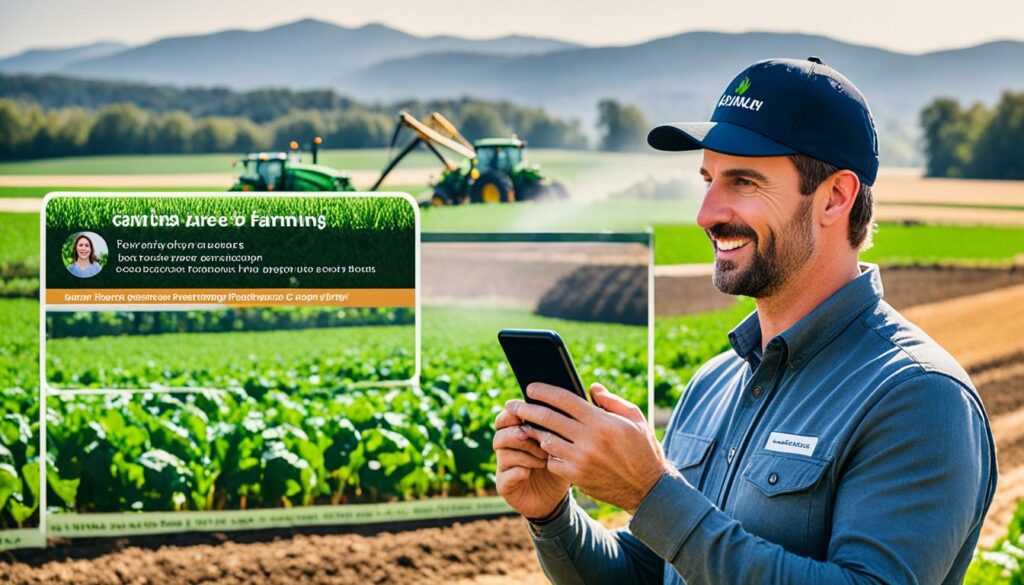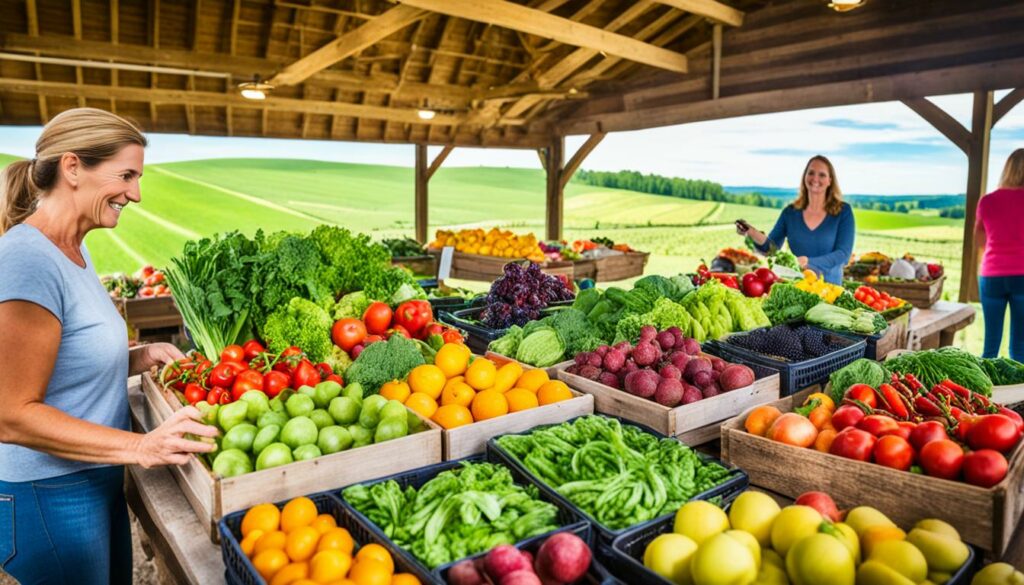Menu

Did you know 70 percent of farmers use the internet daily? Many do so several times a day. These findings show how live video on social media platforms can help farm businesses. With live video, farms can reach out to customers, gain followers, and offer educational content in real-time.
This new approach lets farms display their work, spotlight their items, and put a face to their name online. This way, they can connect personally with the people who follow them.
For farms, using live video is a great strategy. It attracts viewers, guiding them towards a purchase and enhancing the farm’s online presence. Picture a farmer giving a live tour of their farm, showing eco-friendly actions, or answering questions live. These efforts grab people’s interest, increasing trust and loyalty.
Using live video on social media changes how businesses talk to their customers. With platforms like Facebook, Instagram, and YouTube, sharing live videos is simple. Viewers can chat with the uploader and ask questions, making the connection more personal.
For example, 69% of American adults use Facebook. YouTube is even more popular, with 73% U.S. adult users. Especially among young adults and Hispanic communities, the platforms are very effective. They also push live content up, boosting the visibility of the content.
Live streaming can change a brand’s presence on social media. It makes the brand feel more human, engaging viewers. People can see how farming works, ask questions, and get closer to the process. This helps farmers reach more people and grow their online audience.
Live videos also let agricultural businesses show off their products. They can give sneak peeks and show how things are done. This is something viewers like a lot nowadays. With platforms like Alibaba’s Taobao leading the way, the strategy of live streaming is powerful. Even platforms in the west, such as Amazon Live, are starting to see its value.
Yet, succeeding on social media, even with big user bases, needs careful planning. By using these video streaming platforms well, agricultural businesses can stand out. They can attract more customers and build a strong, loyal following.
Livestreaming is a vital tool for farming brands. It helps them connect more with customers. This way, the brand gets known more widely.
Livestreaming lets customers get closer to farming businesses. Through videos, these businesses can show how they work. They can also answer questions live. This makes the brand feel more real. It lets customers talk directly to the people behind the scenes.

Livestreaming helps farming brands break the distance barrier. It lets them talk to more people online. Through video, they can showcase their goods and skills.
This means more people can learn about what they offer. It often leads to more sales and fans.
Trust is crucial for any brand. By showing their work live, farming businesses gain this trust. They show they know their stuff and are honest.
As a result, people trust them more. They keep coming back for their products. This is changing how farming products are advertised and sold.
Choosing the right video streaming platform is key for better engagement. Let’s look at some top choices for your business.
Facebook Live is a strong choice with its broad user base. It’s good for talking in real time and interacting with several users at once. This makes it great for showing live farm tours and demos.
Instagram Live is visually engaging with features like filters and polls. This is perfect for showing off the beauty of your farm and products. It makes a unique and immersive experience for your viewers.
YouTube Live is great if you know your way around video marketing. It offers quality videos and a chance to earn from them. It’s good for making longer videos, with analytics and a big searchable audience.
TikTok Live is all the rage with the younger crowd. It fits short and lively content. It also lets viewers send ‘gifts’. Use it to make fun yet informative videos about your farm or what goes on behind the scenes.
X (formerly Twitter) Live is unique for live streaming. It’s great for quick, real-time conversations to engage your audience fast. Ideal for updating customers, handling questions, or making news about new products.
| Platform | Key Features | Ideal For | Audience Engagement |
|---|---|---|---|
| Facebook Live | Real-time interactions, Multi-user participation | Broad audience reach | High |
| Instagram Live | Filters, Polls, Collaborations | Visual branding | High |
| YouTube Live | High-quality video, Extensive analytics | Long-form content | Moderate |
| TikTok Live | Monetisation through gifts, Dynamic content | Younger demographic | High |
| X Live | Real-time interaction, Immediate updates | Timely updates | High |
The way we see live stream farming is changing the game for agriculture. It uses social media for farmers to reach more people. This case study looks at how China is using live video to change farming.

From 2017 to 2020, China’s online shopping market grew by over 280%. This made it perfect for live videos to take off. Over 1 million people, known as influencers, use live videos to show off farms with tours and Q&A sessions.
Viya is a top influencer who streams four hours every night, seven days a week. She sells 30 to 40 products each stream. During one stream, she even sold a $5.6 million rocket launch, which amazed 37 million viewers. This shows the huge benefit of live stream farming in connecting with people.
Influencers like Jin He are important after one to two months of intensive training. They help farmers build a strong presence on social media. People like Jin He can make between $30,000 to $45,000 USD each month. About half of China’s internet users shop using livestreams, showing how much they trust this way of selling.
The table below shows some key points:
| Aspect | Details |
|---|---|
| Market Growth (2017-2020) | 280% |
| Estimated Revenue (2022) | $500 billion USD |
| Number of Livestream Influencers | 1 million+ |
| Influencer Earnings (Monthly) | $30,000 – $45,000 USD |
| Viya’s Rocket Launch Sale | $5.6 million USD |
| Internet Users Shopping via Livestream | ~500 million |
This study clearly shows how big and powerful live stream farming can be. By using live videos, farmers can reach out better to people. They not only get more views but also earn trust and belief from their followers.
Setting up a livestream requires you to think carefully about technology. For a great live stream, you need to check the equipment, lighting, and sound, and the internet. These aspects are all very important.
For live stream farming, start with a top-notch smartphone or webcam connected to a computer. A stable camera view is key, so use a tripod. Good sound is critical too. Here’s a list of helpful gear:
Top-notch lighting and sound are vital for a professional livestream. Keeping viewers’ attention is hard; on average, they focus for only 8.5 seconds. Clear visuals are crucial. Use these tips for better lighting and sound:
A good internet connection is a must to avoid stream breaks. It’s best to have over 3 Mbps upload speed for standard video. For HD video, 5 Mbps or more is better. For smooth streaming, follow these tips:
To run a great livestream, focus on keeping people interested and involved. Use interactive features, answer questions, and make sure people stay intrigued. This is especially useful for videos from farming companies.
Talking directly with your viewers is a must for livestreams to work. Good livestreams let people chat as they watch. This means you get instant feedback and everyone can join the conversation.

Q&A sessions that are interactive are key. They keep the audience engaged and feeling part of the show. Plus, they solve people’s questions, making it a great time for learning and chatting.
Keeping your audience hooked is very important. Show different interesting things like live demos, talks by experts, and tours of farms. Mixing it up keeps people watching and joining in.
Live video is really popular and engaging, according to Statista. It shows how powerful live streaming can be. It’s a great way for farm businesses to make exciting livestreams.
Start promoting your livestream well before going live. Agricultural businesses can reach more viewers by using social media, emails, and online forums. This approach creates a strong connection with the audience.
It’s key to announce your livestream on social media. Since over 70% of U.S. adults use YouTube and Facebook, these platforms are vital for outreach. Instagram also offers great potential, especially with its focus on visuals. Use unique strategies for each platform, like creating events on Facebook or using Instagram Stories, to increase hype and participation.
Emails are still a powerful way to promote livestreams, especially to an already interested audience. Sending personalised emails with key livestream details and a captivating teaser can boost engagement. Don’t forget strong calls-to-action to guide your contacts on how to watch.
Community forums about agriculture are goldmines for increasing livestream visibility. Posting about your event on Reddit, farming boards, and specific agricultural forums can attract people deeply interested in farming. Engaging with these platforms through discussions and posts will pull in targeted traffic.
By promoting your livestream ahead of time, you make the most of social media for agriculture. Each promotion step, whether a post, an email, or a forum discussion, helps build excitement. This ensures your livestream captures an audience genuinely excited to interact with your content.
Using live video on social media is a great way for farms to show off their goods. It lets people see the products and how they’re made in real time. This builds trust with customers by showing the farm’s work openly.

Showing off products on a livestream can really work. In 2020, 16% of online shoppers bought something right from a live video. This way, farms grab people’s interest and help them decide to buy.
Offering a look behind the scenes through live video lets farmers show what they do every day. This makes the farm feel more real and shows the hard work that goes into their products. It’s also been found to make customers trust the farm more.
Hearing customers talk about your products on a livestream can really boost a farm’s image. It shows the farm is well-liked, which is great for business. Real-time feedback like this can draw in more shoppers and improve the farm’s online reputation.
Moreover, with 72% of Americans on social media, livestreams are a powerful tool to reach many people.
Livestreams are great for sharing farming knowledge. They let agricultural businesses talk about advanced farming and going green. This helps show their skills and builds a community around eco-friendly farming.
Farm workshops on livestreams attract a bigger crowd. They cover everything from managing crops to new farm tech. Having *live stream farming workshops* lets businesses answer questions in real-time, making learning more engaging.
Showing how to manage a farm efficiently can help lots of other farmers. These livestreams talk about daily tasks, managing resources, and training staff. They make a farm look like a leader in the farming community with their expert advice.
Livestreams can also encourage being eco-friendly. By talking about green farming and using resources wisely, they motivate others to do the same. This not only helps the environment but also connects with people who care about these issues.
With educational livestreams, farms can boost their image and educate their community. Here’s how the different topics help:
| Aspect | Benefit |
|---|---|
| Workshops and Webinars | Engages a broad audience, provides real-time interaction |
| Farm Management Tips | Enhances operational efficiency, establishes authority |
| Sustainability Practices | Promotes eco-friendly methods, aligns with customer values |
To know how well your livestream did, you need to look at different kinds of data. You should check how many people watched, what they thought, and if it was worth the money.

Understanding live video data is key to seeing if your livestream worked. On places like Facebook and YouTube, you can see info like how many people watched and who they are. This info helps you figure out what part of your livestream got the most attention.
For example, Viya’s livestream shopping event in 2020 brought in over 3.5 billion RMB with 87 million watching. This shows how powerful it is to keep an eye on the numbers.
Just looking at numbers isn’t enough. It’s also important to listen to what viewers say. By talking to viewers and reading their comments, you learn what they like and don’t like. This helps you make better livestreams. For example,, many people showed interest in farm products after watching livestream demos. This led to huge sales of 93.68 billion RMB in the first quarter of 2020 in China.
Doing a good job on your livestream costs money. It’s worth counting up how much you spend compared to what you make. This helps you decide if livestreaming is a good investment. The market in China expects the livestream sector to be worth over 12.6 billion USD this year. By keeping track of money, you can make smarter choices for your next streams.
For the best success, combine analytics with feedback and ROI checks. Doing all this can help farm businesses make better livestreams. This, in turn, can lead to more views and more money.
Dealing with live streaming challenges is key for a great broadcast. Preparing for problems makes sure your livestream runs well. This is important for agricultural businesses to make engaging broadcasts that people love.
Making sure your livestream works is vital. Do checks before you go live. Test your internet, sound, and picture. Have backup plans ready, since many people buy things online while watching livestreams.
It’s hard to keep viewers’ attention during a livestream. Use polls, Q&A, and show things live to keep them interested. This really works, as seen with popular streamers who attract millions of shoppers during live events.
Negative comments can be tough but how you deal with them matters. Set rules for managing bad feedback. Answering with kindness and having a team that helps moderate can improve the livestream’s feel and trust from your viewers.
By using these tactics, agricultural businesses can tackle streaming issues better. This can make their broadcasts more interesting and successful.
When livestreaming, it’s vital to know the legal and ethical rules, like privacy laws, who owns the content, and getting permission. Agricultural businesses must follow these rules to keep their content safe and to make sure their customers trust them.

Keeping customer data safe is very important to keep their trust. Big issues like Facebook’s data leaks show how crucial it is to follow privacy laws. These laws are often behind the newest tech, making it harder to stay within the rules.
Using livestreams ethically means making sure you have the right to use the content. With social media and live videos being so common, protecting what you create is more important than ever.
Getting permission before you show people in livestreams is key to doing this ethically. Many forget to ask, but not doing so can cause legal trouble. It’s really important for farms and other businesses to make sure they have the okay to film people, especially in public places.
So, it’s crucial to know and follow these rules for livestreaming. Talking clearly with your customers about their data, and making sure their privacy and consent are top priorities, will help to build trust and keep things ethical.
Adding livestreams to your social media can boost your online presence. Most adults use social media. So, sites like Facebook, Instagram, and YouTube are great for farms. They help us reach out. This part will show you why linking your streams to your marketing goals, keeping a regular schedule, and spreading them on different platforms (cross-platform promotion) are important.
It’s key to match your livestreams with what you want as a business. You might want to sell more, be better known, or teach something. Livestreams need to lead people to buy. This is done by showing your products or services clearly. It’s not just about selling. It also builds trust. This makes your farm stand out by having a clear, strong message.
Being consistent keeps people interested. If viewers know when you’re live, they’re more likely to watch. Keep it short and sweet. After all, people’s attention span is short. Using good visuals helps keep them hooked. Engaging often with your viewers makes them more likely to come back. This builds a loyal group of customers.
Sharing your streams on various platforms gets you more views. Use unique features like tags and stories to get people involved. Tease your livestream on Instagram, Facebook, and YouTube. This makes more people curious. Talking with viewers using polls or Q&As during your stream helps too. It makes your farm more approachable. By doing these things, you’ll create a plan that works well and brings people together.
Live video is amazing for agricultural businesses. It helps them connect with customers in real-time. They can show their products and teach people at the same time.
This makes their brand more visible and builds trust with customers. It also shows clearly how the farming is done.
For farmers, live video makes a big difference. It lets them interact with viewers as things are happening on the farm. Viewers can ask questions and learn about the farming process.
This not only gets people more interested but also makes the farm feel more real online.
For agricultural businesses, platforms like Facebook Live and Instagram Live are great choices. YouTube Live and others are also good options. They each have special features that help reach different types of viewers.
Setting up a livestream for farming demos is quite simple. You just need a smartphone or webcam, good lighting, and sound. A strong and stable internet connection is a must, as well.
Test everything before you go live. This is especially true if you’re streaming from outside.
To keep viewers interested, you should talk directly to them. Use Q&A sessions to interact and keep their attention. When viewers join in and get instant answers, they stay more engaged.
To get more people to watch, make sure to announce your livestream on social media and in emails. Joining online groups related to farming can also help.
This builds up excitement and lets people know when and what to expect.
Livestreams are great for showing your products, giving tours, and sharing what customers think. Being open helps build trust. Potential customers get to see the farm’s products up close.
Yes, absolutely. Livestreams are perfect for teaching. You can host workshops, offer farming tips, and talk about being eco-friendly.
This helps your farm get seen as both a supplier and a knowledgeable source in agriculture.
Look at things like how many viewers you had, how much they interacted, who they are, and what you got back from it. Their direct feedback is also very important.
This tells you how well your livestream did and what you can do better next time.
Livestreaming can sometimes be tough because of tech problems, people not fully paying attention, or negative comments. To beat these, do checks before you start. Make your streams interactive. Also, have a plan for how to deal with bad comments.
Being prepared helps a lot.
When livestreaming, make sure to follow privacy and copyright laws. Always get permission from people you show. Doing this keeps your content honest and legal.
To use livestreams well, fit them with your marketing plans, keep a steady schedule, and promote them across different platforms. This way, your livestreams will help your brand message spread.